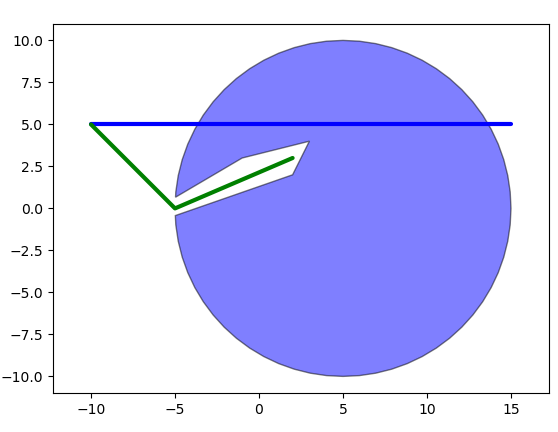方法一:
import numpy as np
a = np.array([0,1,2,3,4,5,5,6,7,8,9])
print(a)
print(a.sum())
# [0 1 2 3 4 5 5 6 7 8 9]
# 50
a = np.ma.array(a, mask=False)
a.mask[3] = True
print(a)
print(a.sum())
# [0 1 2 -- 4 5 5 6 7 8 9]
# 47
方法二
a_new = np.delete(a, 3, 0)
这个3可以是个索引列表分类: 学习
C字符串
想把一列台站名输出成一行,用空格隔开,写了个C。
fgets(buff,1024,fp);
strncpy(temp,buff,strlen(buff)-1);
printf('%s ',temp);发现当台站名由长变短时,会“继承”上一个台站的后面几个字符,比如前一个台站名为L5317,而后一个为Y02时,前一个正确,而后一个会变成Y0217.怀疑是temp保存了上一次的’\0’的位置,所以在每次printf后强行temp[0]=’\0’,发现没用,考虑是上次的字符串终止符还在。
我试了以下几种方法,都行:
1 每次printf后,temp[strlen(a)-1]=’0’;
2 用malloc给temp分配内存,读到了新的,就realloc一次,记得最后free掉; temp=(char *)realloc(temp,sizeof(char)*(strlen(buff)-1))
3 直接把buff数组的最后一个值换成’\0’,然后输出buff。 buff[strlen(buff)-1]=’\0′
pandas中的parse_dates以及绘图
某列中的数据要能被完整parse为时间值,可以用dateutil.parse中的parse来测试一下,不足的位数要补齐。比如一个文件temp.txt包含两列数,一列时间,一列观测数据200101011001 -3.9
import pandas as pd
import matplotlib.pyplot as plt
dat=pd.read_csv(‘temp.txt’,head=0,sep=’\s+’,names=[‘time’,’values’],parse_dates=[‘time’])
dat.plot(x=’time’,y=’values’)
plt.show()
macOS安装X11
https://support.apple.com/zh-cn/HT201341
Mac 不再随附 X11,但 XQuartz 项目会提供 X11 服务器和客户端库。
Apple 创建了 XQuartz 项目,共同致力于在 Mac 上进一步开发和支持 X11。XQuartz 项目最初基于 Mac OS X v10.5 中随附的 X11 版本。目前有多个版本的 XQuartz,其中包含修复程序、针对新功能的支持以及 X11 体验的更多改进功能。Apple 是 XQuartz 项目的贡献者,并致力于确保 X11 与 macOS 和最新版本的 XQuartz 正常配合使用。
XQuartz 项目提供适用于 MacOS 的 X11 服务器和客户端库,网址是 www.xquartz.org。下载可用的最新版本。
////////////////////////////////////////////////////////////////////////////////////////////
专业软件用到了x11,但编译的时候报错说是没有x11,按照以上通知,安装了XQuartz后,程序运行正常。
brew install xquartz
scp通配符
记得加转义字符
安装gempy时PyQt不兼容
直接用brew安装pyqt
macOS安装docker
brew install –cask docker
heapsort快速排序
void sort(float arr[], unsigned int N)
{ // heapsort algorithm
unsigned int n = N, i = n/2, parent, child;
int t;
for (;;) { /* Loops until arr is sorted */
if (i > 0) { /* First stage - Sorting the heap */
i--; /* Save its index to i */
t = arr[i]; /* Save parent value to t */
} else { /* Second stage - Extracting elements in-place */
n--; /* Make the new heap smaller */
if (n == 0) return; /* When the heap is empty, we are done */
t = arr[n]; /* Save last value (it will be overwritten) */
arr[n] = arr[0]; /* Save largest value at the end of arr */
}
parent = i; /* We will start pushing down t from parent */
child = i*2 + 1; /* parent's left child */
/* Sift operation - pushing the value of t down the heap */
while (child < n) {
if (child + 1 < n && arr[child + 1] > arr[child]) {
child++; /* Choose the largest child */
}
if (arr[child] > t) { /* If any child is bigger than the parent */
arr[parent] = arr[child]; /* Move the largest child up */
parent = child; /* Move parent pointer to this child */
//child = parent*2-1; /* Find the next child */
child = parent*2+1; /* the previous line is wrong*/
} else {
break; /* t's place is found */
}
}
arr[parent] = t; /* We save t in the heap */
}
}二分法查找
#include <math.h>
int ifindi(int n,int arr[],int v)
{
int i,begin=0,end=n-1,mid;
if(v<arr[0] || v>arr[n-1])
return -9;
if(n<=0)
return -9;
// mid=rint((end-begin)/2);
while(1)
{
if((end-begin)<=1){
if(arr[begin]==v) return begin;
if(arr[end]==v) return end;
}
mid=begin+rint((end-begin)/2);
// printf("mid=%d\n",mid);
if(v>=arr[begin] && v<arr[mid]) end=mid;
if(v>=arr[mid] && v<=arr[end]) begin=mid;
// printf("begin=%d, end=%d\n",begin,end);
}
}python-判断线段与多边形相交
import numpy as np
import matplotlib.pyplot as plt
import shapely.geometry
import descartes
circle = shapely.geometry.Point(5.0, 0.0).buffer(10.0)
clip_poly = shapely.geometry.Polygon([[-9.5, -2], [2, 2], [3, 4], [-1, 3]])
clipped_shape = circle.difference(clip_poly)
line = shapely.geometry.LineString([[-10, -5], [15, 5]])
line2 = shapely.geometry.LineString([[-10, -5], [-5, 0], [2, 3]])
print 'Blue line intersects clipped shape:', line.intersects(clipped_shape)
print 'Green line intersects clipped shape:', line2.intersects(clipped_shape)
fig = plt.figure()
ax = fig.add_subplot(111)
ax.plot(*np.array(line).T, color='blue', linewidth=3, solid_capstyle='round')
ax.plot(*np.array(line2).T, color='green', linewidth=3, solid_capstyle='round')
ax.add_patch(descartes.PolygonPatch(clipped_shape, fc='blue', alpha=0.5))
ax.axis('equal')
plt.show()Blue line intersects clipped shape: True
Green line intersects clipped shape: False